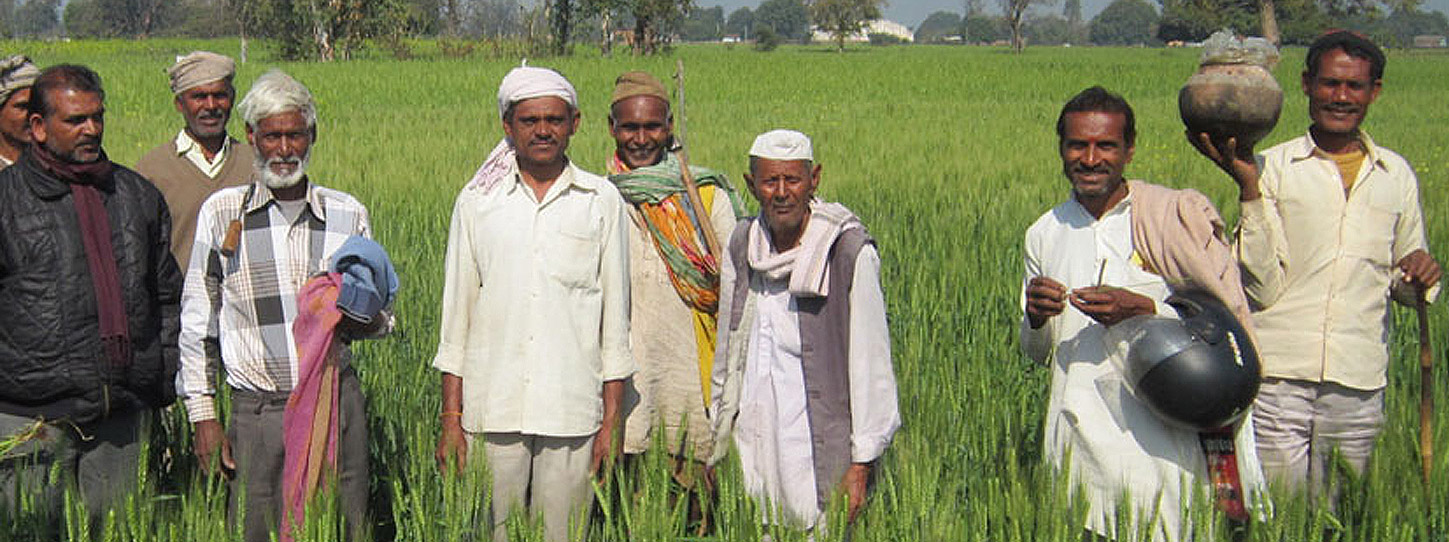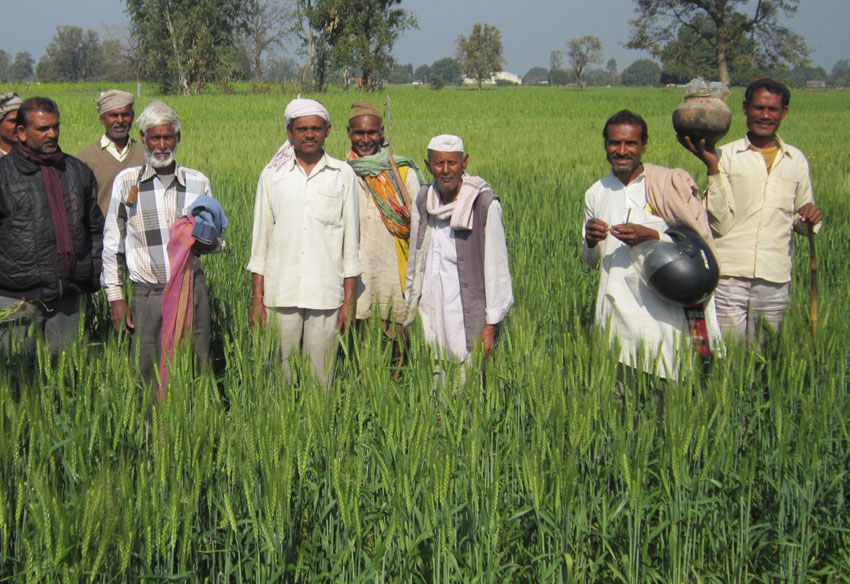
When Dharamdas Ahirwar started the ‘blended’ wheat cultivation model, his family and neighbors branded his innovation as an absurd and harebrained scheme. However, as soon as the tillers and panicles emerged in his trial plot, the opposition from his family and ridicule of fellow-farmers evaporated. And by the time the plot was harvested, the entire village stood in admiration. Dharamdas is now hailed as an innovator in his village.
Dharamdas is a smallholder farmer associated with Ambedkar Small Holder Farmers’ Collective (SHFC) of Amarmau village of Sagar district. The SHFC was constituted by Caritas India under its Strengthening Adaptive Farming in Bangladesh, India and Nepal (SAFBIN) programme which creates reflection platforms for smallholder farmers who depend on rain-fed farming for subsistence. SAFBIN is a European Union (EU) supported agriculture research and development programme that seeks to develop sustainable agriculture models that can withstand the perils of climate change.

Dharamdas (far right), with a pitcher of Matka Khaad, leading a peer learning session of farmers on his trial plot
“The first response that I received from my family members when I shared my plan of cultivating wheat differently was an emphatic no. I was prepared to face their opposition because they had never even heard of such cultivation pattern” Dharamdas said. With much goading, he managed to get a favorable response from his family to start the trial but with a rider – none of his family members would assist him and he will have to do everything. The condition was agreeable to this enterprising 44-year old illiterate farmer because he had all reasons to believe that his trial would succeed.
While attributing the credit to SAFBIN, Dharamdas says that the wheat trial plan was discussed in one of the SHFC meetings. “Wheat cultivation in the region was becoming more unsustainable due to insufficiency of irrigation facility, erratic monsoon season and increasing cost of fertilizer and pesticides. For our survival, we have to identify an alternative farming model which involves lesser inputs and water”, Dharamdas said. Mr. Rajesh Namdev, SAFBIN’s village research worker in Amarmau helped the farmers understand the concept of System of Wheat Intensification (SWI). SAFBIN also helped the small farmers prepare and administer various botanical solutions as substitutes for chemical inputs.
SAFBIN envisages developing potential candidate agriculture models of food crops by blending traditional practices and locally suitable modern agriculture practices with the objective of securing food and nutrition security of smallholder farmers.
After several rounds of meetings, Ambedkar SHFC finalised a wheat cultivation system modeled on SWI and organic farming. “Dharamdas was one of the first farmers of the village to volunteer to do the trial with no assistance at all”, Mr. Rajesh Namdev said. While preparing his 1.5-acre land, Dharamdas demarcated the trial plot measuring 10 x 10 meter in one corner of his farm. His family expressed concern when Dharamdas told them that he would use just 200 gram seed on the trial plot. Farmers normally use at least 1.2 kg seed on a farm of comparable size. The concern of family members soon gave way to alarm when Dharamdas, as against the practice of broadcasting, planted the seeds in lines, with 20 centimeter space between them, with the help of a dibble.
Some farmers and his own family members frequently visited Dharamdas’ trial for observing the ‘failure’ that they expected to see on the trial plot. “During the germination stage, the plant population in the trial plot was far less than that was recorded in other farms where the same seed was broadcasted. Some farmers sneered when they saw the trial plot with scanty plant population and my family members wrote the trial off as my misadventure” Dharamdas said with a smile. Despite the initial indications of failure, Dharamdas persisted with other practices which were finalised by the SHFC. He sprung yet another surprise when he broke the tradition of using chemical inputs. Instead using purchased inputs from market, he prepared fish manure and Matka Khaad – a botanical solution entirely prepared with local materials. He administered these solutions as growth promoters. This helped him bring down the input cost significantly to Rs. 100 which is less than 10 per cent of the normal expenditure of a farmer on a plot of comparable size.
With robust vegetative growth, which was unseen and unheard of in the entire village, the trial plot started answering for Dharamdas. Wheat plants had an average tiller count of 22 whereas the average tiller count of other farms was a meager 4. By the time panicles emerged the skeptics had already fallen silent. The panicles were nearly 1.5 times longer than the average panicle size of other farms. Farmers who used to visit Dharamdas’ trial plot for purported purpose of witnessing the ‘failure’ continued their visits – now for witnessing the success. Harvest sample taken from two sample sub-plots of trial plot pegged the yield of Dharmdas’ wheat cultivation model at 14.25 tonnes per hectare whereas other farmers of Amarmau achieved a maximum yield of 10.25 tonnes per hectare. Incidentally, Amarmau village with no irrigation connectivity suffers from severe water stress during winter crop.
Dharamdas now says that his family and farmer friends, finally, are convinced of the merits of his wheat cultivation model. More importantly, his family and farmer friends are planning to adopt the new system of wheat cultivation from the next crop season. While summing up his pleasant trial experience Dharamdas said, “Achhi cheez shuru main hamesha thik nahi dikhti. lekin dhairya rakhne par sab kuchh achha ho jata hai”. (Good things need not look good at the beginning. We need to be patient to see how it unfolds as real good).